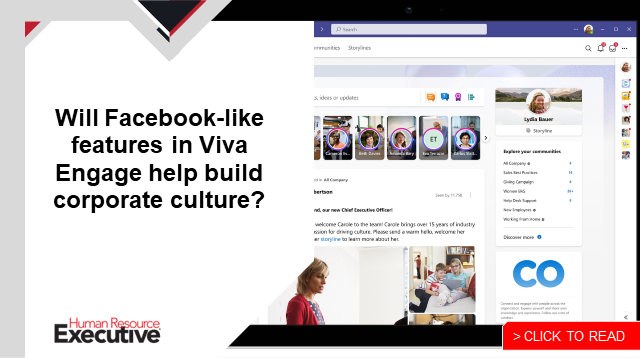The Great Resignation (also known as the “Great Reshuffle”) is still in full swing. It has become increasingly challenging to retain high-performing employees during this competitive time for talent. According to Gallup, replacing an individual employee can cost the employer from one-half to two times the person’s annual salary. As a result, now more than ever, organizations must prioritize the employee experience to avoid costly staff turnover, which lowers morale and negatively impacts the productivity of the team members left to pick up the slack.
Below are five steps organizations can take to support team members and drive employee satisfaction:
1. Cultivate a welcoming and engaging culture
Employee engagement is integral to high performance and critical to retention. However, according to recent research from Gallup, just 20% of global employees are engaged at work. Organizations must make people feel secure, appreciated and respected so they are empowered to think outside the box, collaborate and find purpose in their jobs.
Communicate with employees to ensure everyone has the tools and resources to eliminate frustration and make it easy for people to find and share information and perform their jobs effectively.
 Prioritize the employee experience by providing opportunities to strengthen social bonds, such as through offering a hub or virtual water cooler for non-work-related conversations and regularly scheduling company activities and outings. In addition, provide a dedicated feedback center that encourages the entire team to weigh in on meaningful discussions and interact. As well, have a digital “kudos” section that allows all employees to give shoutouts to their peers and others to weigh in with their high fives.
Prioritize the employee experience by providing opportunities to strengthen social bonds, such as through offering a hub or virtual water cooler for non-work-related conversations and regularly scheduling company activities and outings. In addition, provide a dedicated feedback center that encourages the entire team to weigh in on meaningful discussions and interact. As well, have a digital “kudos” section that allows all employees to give shoutouts to their peers and others to weigh in with their high fives.
2. Establish an effective onboarding program
While businesses have attempted to revamp their onboarding programs in response to the competitive labor market, most still do not meet employees’ expectations, with recent research finding that only 12% of employees strongly agree that their company does a great job onboarding employees. When onboarding falls short of employees’ expectations, productivity declines and turnover rises.
A digital onboarding hub is a cost-effective way to drive productivity by engaging with new team members from the start. A supportive onboarding center includes new employee checklists, a digital employee handbook, links to important forms, contact information for key colleagues and an FAQ section. It also provides an opportunity for new employees to get better acquainted with the company culture and values, connect with co-workers and ask questions. You can take it a step further and have individual departmental onboarding playbooks. After completing corporate onboarding, new hires can start learning about their role and get access to all written processes and procedures to refer to while having hands-on training with their peers.
3. Invest in employee development
When people feel like they are in a dead-end job, they will search for a more rewarding position. In fact, 83% of workers report leaving their jobs because they no longer felt like they were growing in their position, according to research from Cengage Group.
Given this, it’s important to ensure employees see growth potential within the organization and commit to investing in training and professional development, so people feel valued and motivated to stay. A digital workplace can be a powerful tool for employee development. Ensure valuable company knowledge is easily accessible to everyone through the intranet. Feature training and development opportunities with a calendar of courses. Use the company blog to spotlight employees’ success stories.
4. Clearly and openly communicate corporate and employee goals
 Effective communication is crucial in every workplace. Regrettably, communication challenges are real and can be common between senior leaders and employees, having an enduring effect on overall business performance and workplace culture. In fact, Grant Thornton found that 45% of employees do not believe their employer understands their needs as an employee, and 40% feel their voice is not heard at work.
Effective communication is crucial in every workplace. Regrettably, communication challenges are real and can be common between senior leaders and employees, having an enduring effect on overall business performance and workplace culture. In fact, Grant Thornton found that 45% of employees do not believe their employer understands their needs as an employee, and 40% feel their voice is not heard at work.
Communication should flow in all directions—from the top-down, bottom-up and everywhere in between. But every message needs the right medium to ensure its effectiveness. A digital workplace solution like intranet technology can be ideal for creating an open line of communication between in-office or remote employees and their workplace leaders. It creates a place for leadership blogging, employee chatter, company announcements and much more, serving as a rescue key for conversations from the depths of instant message threads and email inboxes.
For example, senior team members can share a post or workplace update with their specific team or with an individual team member, on which employees are free to comment or pose a question. From a corporate communication perspective, it enables organizations to open up and ensure regular corporate updates from the CEO or senior leaders. This open line of communication can deliver company objectives and create alignment for end goals for both in-office and remote employees.
5. Take work/life balance seriously
 If team members are feeling burnt out, their wellbeing and productivity will suffer, and a lack of work/life balance directly impacts employee turnover. In the hybrid world, employees are looking for flexibility and perks that contribute to their overall quality of life. For instance, Gallup found that 51% of employees would change jobs for one that allows them to adjust their work hours to create a better work/life balance.
If team members are feeling burnt out, their wellbeing and productivity will suffer, and a lack of work/life balance directly impacts employee turnover. In the hybrid world, employees are looking for flexibility and perks that contribute to their overall quality of life. For instance, Gallup found that 51% of employees would change jobs for one that allows them to adjust their work hours to create a better work/life balance.
Beyond allowing people to make their own schedules, encourage everyone to take their breaks and use their vacation time, while ensuring they are compensated for work outside of regular business hours. Consider employees’ physical and mental health and create a robust health and wellness center that includes helpful blogs, tips and advice and encourages team members to share information.
The pandemic has led employers and employees to reevaluate what is important to them. Increasingly, employees are examining if their current position meets their needs. For organizations to keep their best talent, they must provide people with the support and resources necessary to thrive. From the day a new hire starts, a strategic digital workplace enables collaboration and communication, which are crucial throughout the entire employee journey.
The post 5 ways to retain high-performing employees appeared first on HR Executive.